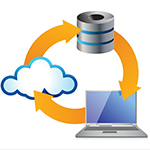
If you’re turning to cloud services to handle your data backup and disaster recovery needs, you’re not alone.
According to one survey conducted a few months ago by TechTarget and Computer Weekly, the adoption of cloud services for DR and business continuity will jump from just under 18% of enterprises to more than 28% in a mere six months.
A quick glance at some Forrester Research numbers reveals something about why DRaaS is catching on. The amount of data organizations currently maintain has grown 46% between 2010 and 2012 — from a mean of 2,175 terabytes per organization to 3,183 terabytes. A look at the kind of data stored reveals that backup data is mushrooming:
| Data category | 2010-2012 % change | |
| Unstructured data | Enterprise content management |
54% |
| Digital & web content repositories |
56% |
|
| General file storage |
28% |
|
| Structured data | Database systems |
15% |
| Secondary/tertiary data | Archiving |
45% |
| Server backups |
42% |
|
| PC backups |
98% |
|
| Other data |
44% |
Source: Forrsights Hardware Survey, Q3 2012
Beware the tendency, however, to toss data into a cloud and not think much about it again. This can get you into plenty of trouble if you can’t recover the data when you need it. So take care to ensure data and apps are backed up properly and can be recovered when and where you need. The TechTarget/Computer Weekly survey found that despite the increasing use of cloud for DR, only 43% of respondents said they can recover data via their cloud DR service. And fully 75% indicated that they have not tested their cloud DR service.
In fact, despite the use of cloud DR, archaic DR practices persist. Research points to, at minimum, a third of organizations still placing some of their DR data on tape— and at least one survey suggests this figure is as high as two-thirds of organizations. This last survey, conducted earlier this year by Information Week, also shows that almost 40% of organizations do not encrypt any backup data, and 43% do not back up any data at remote offices and sites.
The good news is that using cloud services for data backup and disaster recovery/business continuity has been shown to pay off, especially for smaller businesses. In research from Symantec done last year, more than 40% said that cloud migration had improved their disaster readiness, as did 36% of those implementing mobile devices.
But it’s critically important to update your disaster recovery/business continuity best practices as you upgrade your data backup and DR to the cloud. In my next blog post, I’ll lay out the top 10 Cloud DR/BC best practices.
